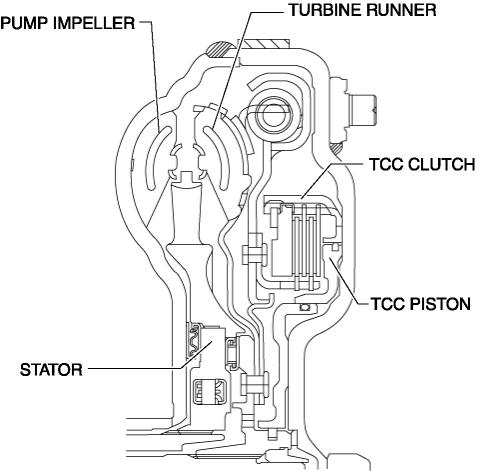Mazda CX-5 Service & Repair Manual: Torque Converter [Fw6 A EL, Fw6 Ax EL]
Purpose/Function
-
By use of an optimized torus shape (wing) matching the output characteristics of the engine, the torque converter achieves efficient force transmission and reduced fuel consumption.
Construction/Operation
-
A three-member, single-stage two-phase type torque converter with a torque converter clutch (TCC) mechanism has been adopted.
-
Three-member: Indicates that the torque converter consists of a pump impeller, turbine runner, and stator.
-
Single stage: Indicates the number of turbine runners.
-
Two-phase: Indicates that there are two conditions; torque converter range and fluid coupling range.
TCC mechanism
-
A TCC piston built into the torque converter operates during TCC control. When hydraulic pressure is applied to the TCC piston, the TCC clutch engages to mechanically connect the pump impeller to the turbine runner. The TCC mechanism achieves excellent fuel economy as a result of no loss in drive force transmission due to torque converter slippage. In addition, precise hydraulic control is made possible by a multi-plate clutch equipped with an independent piston housing. With the adoption of this mechanism, the achievable range of TCC control has widened dramatically.

 Torque Converter Clutch (TCC) Control [Fw6 A EL, Fw6 Ax EL]
Torque Converter Clutch (TCC) Control [Fw6 A EL, Fw6 Ax EL]
Outline
For TCC control, a newly developed, full range TCC control has been adopted.
The TCC range has been significantly widened by having the smoothness unique
to the torque converter d ...
 Transmission/Transaxle Abbreviations
Transmission/Transaxle Abbreviations
AAS
Active Adaptive Shift
ABS
Antilock Brake System
ABDC
After Bottom Dead Center
ACC
Access ...
Other materials:
Blind Spot Monitoring (Bsm) System
Outline
The blind spot monitoring (BSM) system detects vehicles approaching from
the rear blind spots, and illuminates the BSM indicator light on the outer mirror
glass. When the BSM indicator light is illuminated and the turn light switch
is turned on to the side in which the indica ...
Air Bag System [Standard Deployment Control System]
Outline
The air bag system is a device that supplements the passenger restraint function
of the seat belts. The air bag system will not have the designed effect if the
seat belts are not worn properly.
The air bag system is composed of the following parts:
...
Side Air Bag Sensor Removal/Installation [Two Step Deployment Control System]
WARNING:
Handling the side air bag sensor improperly can accidentally operate (deploy)
the air bag module, which may seriously injure you. Read the air bag system
service warnings and cautions before handling the side air bag sensor..
1. Switch the ignition to off.
2. Disconnec ...
